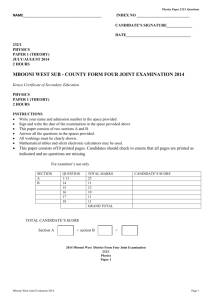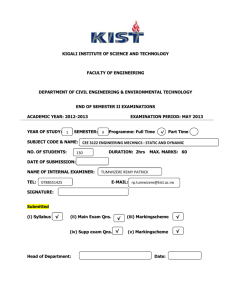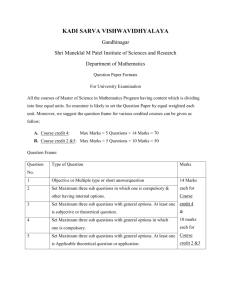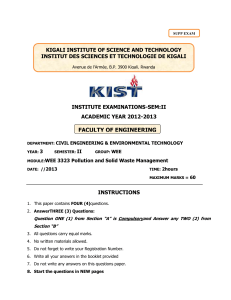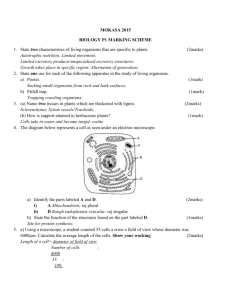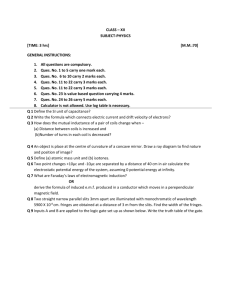Y3 SemII Pollution & Solid Waste Mgt 2013
advertisement
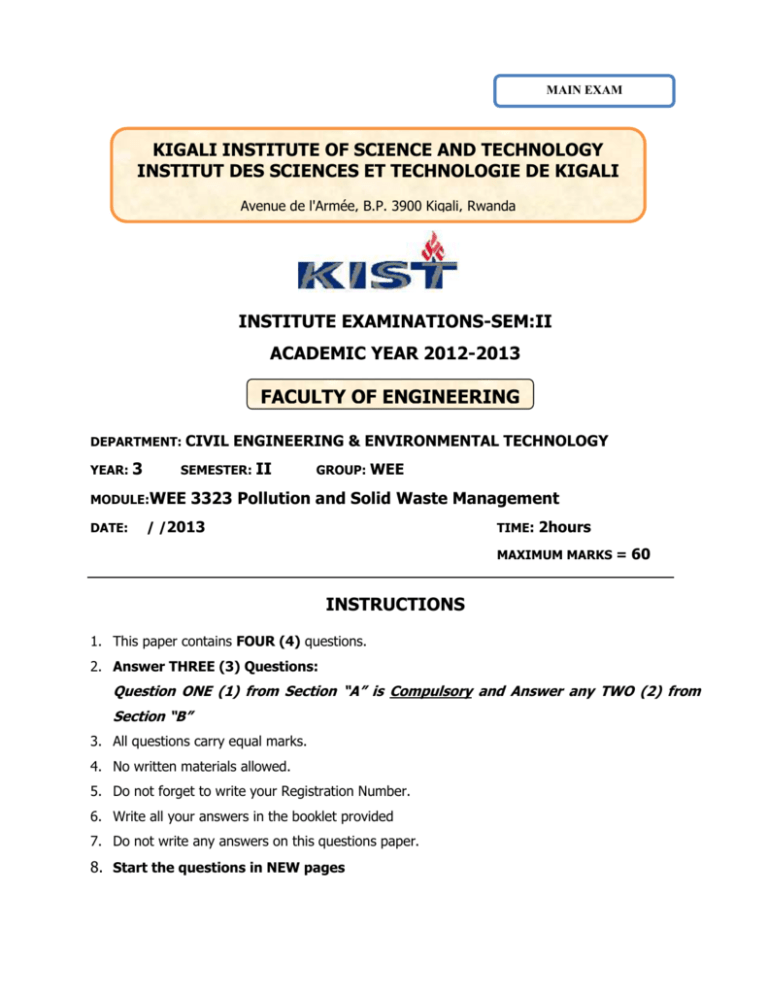
MAIN EXAM KIGALI INSTITUTE OF SCIENCE AND TECHNOLOGY INSTITUT DES SCIENCES ET TECHNOLOGIE DE KIGALI Avenue de l'Armée, B.P. 3900 Kigali, Rwanda INSTITUTE EXAMINATIONS-SEM:II ACADEMIC YEAR 2012-2013 FACULTY OF ENGINEERING DEPARTMENT: CIVIL YEAR: 3 SEMESTER: II MODULE:WEE DATE: ENGINEERING & ENVIRONMENTAL TECHNOLOGY GROUP: WEE 3323 Pollution and Solid Waste Management / /2013 TIME: 2hours MAXIMUM MARKS = 60 INSTRUCTIONS 1. This paper contains FOUR (4) questions. 2. Answer THREE (3) Questions: Question ONE (1) from Section “A” is Compulsory and Answer any TWO (2) from Section “B” 3. All questions carry equal marks. 4. No written materials allowed. 5. Do not forget to write your Registration Number. 6. Write all your answers in the booklet provided 7. Do not write any answers on this questions paper. 8. Start the questions in NEW pages SECTION A Question One: /20 Marks a) What is meant by environment pollution?/4marks b) i. What is air pollution? /2marks ii. What Causes air Pollution?/2marks iii. What are the consequences of air pollution?/2 Marks c) Briefly describe the solid waste streams /10Marks SECTION B Question Two: /20 Marks a) The Clean Air Act of 1970 mandated the setting of standards for four of the primary pollutants. Give those four primary pollutants. /4 Marks b) Describe how Polluter pays principles and Solid Waste Hierarchy can be employed as Concepts to Solid Waste Management. /10 Marks c) State six Health Effects of pollution emissions. /6Marks Question Three: /20 Marks a) What are the kinds of wastes? /4 Marks b) What do you understand by biomedical waste? Categorize biomedical waste and determine its management./10Marks c) What are the concerns associated with open burning./6Marks Question Four: /20 Marks a) Describe how Integrated Solid waste Management (ISWM) system can be employed as an overall solid waste management approach to creating sustainable systems that are economically affordable, socially acceptable and environmentally effective./10Marks b) Give account definite of the consequences of poor waste management in Kigali City? /10Marks GOOD LUCK SECTION A Question One: /20 Marks a) What is meant by environment pollution? /4Marks R/: Environment pollution can be made by human activity and by natural forces as well.1Mark Environmental pollution is tangled with the unsustainable anthropogenic activities, resulting in substantial public health problems such as: i) cancer, ii) birth defects, and iii) asthma, many of which may be associated with environmental exposures.3Marks b) i. What is air pollution? /2 Marks ii. What Causes air Pollution? /2 Marks iii. What are the consequences of air pollution?/2Marks R/: Air pollution may be defined as the presence in the air (outdoor atmosphere) of one or more contaminants or combinations thereof in such quantities and of such durations as may be or tend to be injurious to human, animal or plant life, or property, or which unreasonably interferes with the comfortable enjoyment of life or property or conduct of business.2Marks One of the main causes of air pollution is the release of carbon dioxide into the atmosphere, this happens because of Deforestation and fossil fuel burning. Sulfur dioxide is another air polluter and is released into the atmosphere by the burning of sulfur containing compounds of fossil fuels.2Marks The consequences of air pollution: CO2 is a good transmitter of sunlight, but it also partially restricts infrared radiation going back from the earth into space, which produces the so-called greenhouse effect that prevents a drastic cooling of the Earth during the night. 2Marks c) Briefly describe the solid waste streams/10Marks R/:WASTE STREAMS Municipal Waste management is the collection, transport, processing, recycling or disposal, and monitoring of waste materials. Waste management is also carried out to recover resources from it. Waste management can involve solid, liquid, and gaseous substances, with different methods and fields of expertise for each. Waste reduction methods: An important method of waste management is the prevention of waste material being created, also known as waste reduction. Methods of avoidance include reuse of second-hand products and repairing broken items instead of buying new.2Marks Recycling: Items that are usually composed of a single type of material are relatively easy to recycle into new products i.e. paper and plastics. The recycling of complex products (such as computers and electronic equipment) is more difficult, due to the additional dismantling and separation required.2Marks Composting: Waste materials that are organic in nature, such as plant material, food scraps, and paper products, can be recycled using biological composting and digestion processes to decompose the organic matter. The resulting organic material is then recycled as mulch or compost for agricultural.2Marks Landfill: Disposing of waste in a landfill involves burying the waste. A properly-designed and wellmanaged landfill can be a hygienic and relatively inexpensive method of disposing of waste materials.2Marks Incineration: Incineration is a disposal method that involves combustion of waste material. Incineration and other high temperature waste treatment systems are sometimes described as "thermal treatment". Incinerators convert waste materials into heat, gas, steam, and ash. 2Marks SECTION B Question Two: /20 Marks a) The Clean Air Act of 1970 mandated the setting of standards for four of the primary pollutants. Give those four primary pollutants. /4 Marks R/: particulates, 1Mark sulfur dioxide,1Mark carbon monoxide, 1Mark Nitrogen.1Mark b) Describe how Polluter pays principles and Solid Waste Hierarchy can be employed as Concepts to Solid Waste Management. /10 Marks R/: Solid waste management concepts There are a number of widely-used concepts about waste management: Solid Waste hierarchy: 5Marks The waste hierarchy refers to the "3 Rs" reduce, reuse and recycle, which classify waste management strategies according to their desirability in terms of waste minimization.3 Marks The solid waste hierarchy remains the cornerstone of most waste minimization strategies.1 Mark The aim of the waste hierarchy is to extract the maximum practical benefits from products and to generate the minimum amount of waste.1Mark Polluter pays principle: 5Marks The Polluter Pays Principle is a principle where the polluting party pays for the impact caused to the environment. With respect to waste management, this generally refers to the requirement for a waste generator to pay for appropriate disposal of the waste.Education and awareness in the area of waste and waste management is increasingly important. c) State six Health Effects of pollution emissions. /6Marks R/: Aggravation of respiratory and cardiovascular disease; 1Mark decreased lung function; 1Mark increased frequency and severity of respiratory symptoms such as difficulty breathing and coughing;1Mark increased susceptibility to respiratory infections; 1Mark effects on the nervous system, including the brain, such as IQ loss and1Mark Impacts on learning, memory, and behavior; cancer; and premature death.1Mark Question Three: /20 Marks a) What are the kinds of wastes? /4 Marks R/:Kinds of Wastes Solid wastes: domestic, commercial and industrial wastes especially common as codisposal of wastes. Examples: plastics, styrofoam containers, bottles, cans, papers, scrap iron, and other trash.2Marks Liquid Wastes: wastes in liquid form. Examples: domestic washings, chemicals, oils, waste water from ponds, manufacturing industries and other sources. 2Marks b) What do you understand by biomedical waste? Categorize biomedical waste and determine its management. /10Marks R/: Biomedical waste: 1 Mark Biomedical waste consists of solids, liquids, sharps, and laboratory waste that are potentially infectious or dangerous. It must be properly managed to protect the general public, specifically healthcare and sanitation workers who are regularly exposed to biomedical waste as an occupational hazard. The following is a list of materials that are generally considered biomedical waste: 4 Marks Solids: Catheters and tubes, disposable gowns and masks, disposable tools, such as some scalpels and surgical staplers, medical gloves, surgical sutures and staples, and wound dressings. 1 Mark Liquids: blood, body fluids and tissues, cell, organ, and tissue cultures. 1 Mark Sharps: blades, razors, scalpel blades, needles, and syringes. 1 Mark Laboratory waste: animal carcasses, hazardous chemicals.1 Mark Management: 5Marks Sorting of medical wastes in hospital: At the site where it is generated, biomedical waste is placed in specially-labelled bags and containers for removal by biomedical waste transporters. 1 Mark Other forms of waste should not be mixed with biomedical waste as different rules apply to the treatment of different types of waste. 1 Mark Biomedical waste is treated by any or a combination of the following methods: incineration or steam, chemical, or microwave sterilization. Any tools or equipment that come into contact with potentially infectious material and are not disposable or designed for single-use are sterilized in an autoclave.3 Marks c) What are the concerns associated with open burning. /6Marks R/: Open burning has many negative effects on both human health and the environment. This uncontrolled burning of garbage releases many pollutants into the atmosphere. 2Marks These include dioxins, particulate matter, polycyclic aromatic compounds, volatile organic compounds, carbon monoxide, hexachlorobenzene and ash. All of these chemicals pose serious risks to human health. 2 Marks The harmful effects of open burning are also felt by the environment. This process releases acidic gases such as the halo-hydrides; it also may release the oxides of nitrogen and carbon. Nitrogen oxides contribute to acid rain, ozone depletion, smog and global warming.2Marks Question Four: /20 Marks a) Describe how Integrated Solid waste Management (ISWM) system can be employed as an overall solid waste management approach to creating sustainable systems that are economically affordable, socially acceptable and environmentally effective. /10Marks Integrated Solid Waste Management (ISWM) takes an overall approach to creating sustainable systems that are economically affordable, socially acceptable and environmentally effective.2 Marks An integrated solid waste management system involves the use of a range of different treatment methods, and key to the functioning of such a system is the collection and sorting of the waste. 2 Marks It is important to note that no one single treatment method can manage all the waste materials in an environmentally effective way. 2 Marks Thus all of the available treatment and disposal options must be evaluated equally and the best combination of the available options suited to the particular community chosen.2 Marks Effective management schemes therefore need to operate in ways which best meet current social, economic, and environmental conditions of the municipality.2 Marks b) Give account definite of the consequences of poor waste management in Kigali City? /10Marks Infrastrural destruction: Garbage is dumped hazard in manholes of drainage sewage systems leading to blockages of sewages pipes causing floods of sewage across the roads and blockage of the toilets rendering them nonfunctional. Blockage of manholes and roads side gutters lead to the ponding effect and consequential flooding of the city roads. These attract repairs and maintenance that disrupts many activities. 3 Marks Contamination of water bodies: Most of the garbage dumping is done in wetlands including Kigali City. And these wetlands are a major source of drinking water for Kigali Population. The percolating leachates from the garbage into the soil often find their way into the underground water table and protected springs.3 Marks Sanitation and Health: Open dumping is the mode of garbage disposal in Kigali City as traditional method. It is scenery of flies, rodents and others vectors that scramble for decomposing. This method of waste management exposes public to danger of various communicable diseases such as diarrhea, cholera, dysenteries, etc. Some of the pathological wastes are contaminated in the wastes and are eminent sources of epidemiological effects.4Marks THANK YOU
